Refinery Operations Optimization
VerifiedAdded on 2020/04/21
|13
|1315
|84
AI Summary
This solved assignment delves into the complexities of optimizing refinery operations. It presents a mathematical model for maximizing profit by considering various factors like crude oil types, product demands, processing limitations, and economic values. The solution utilizes Excel to determine the optimal quantities of each product to be produced, given specific constraints and objectives. Additionally, the assignment explores the impact of investment in capacity expansion on profitability.
Contribute Materials
Your contribution can guide someone’s learning journey. Share your
documents today.
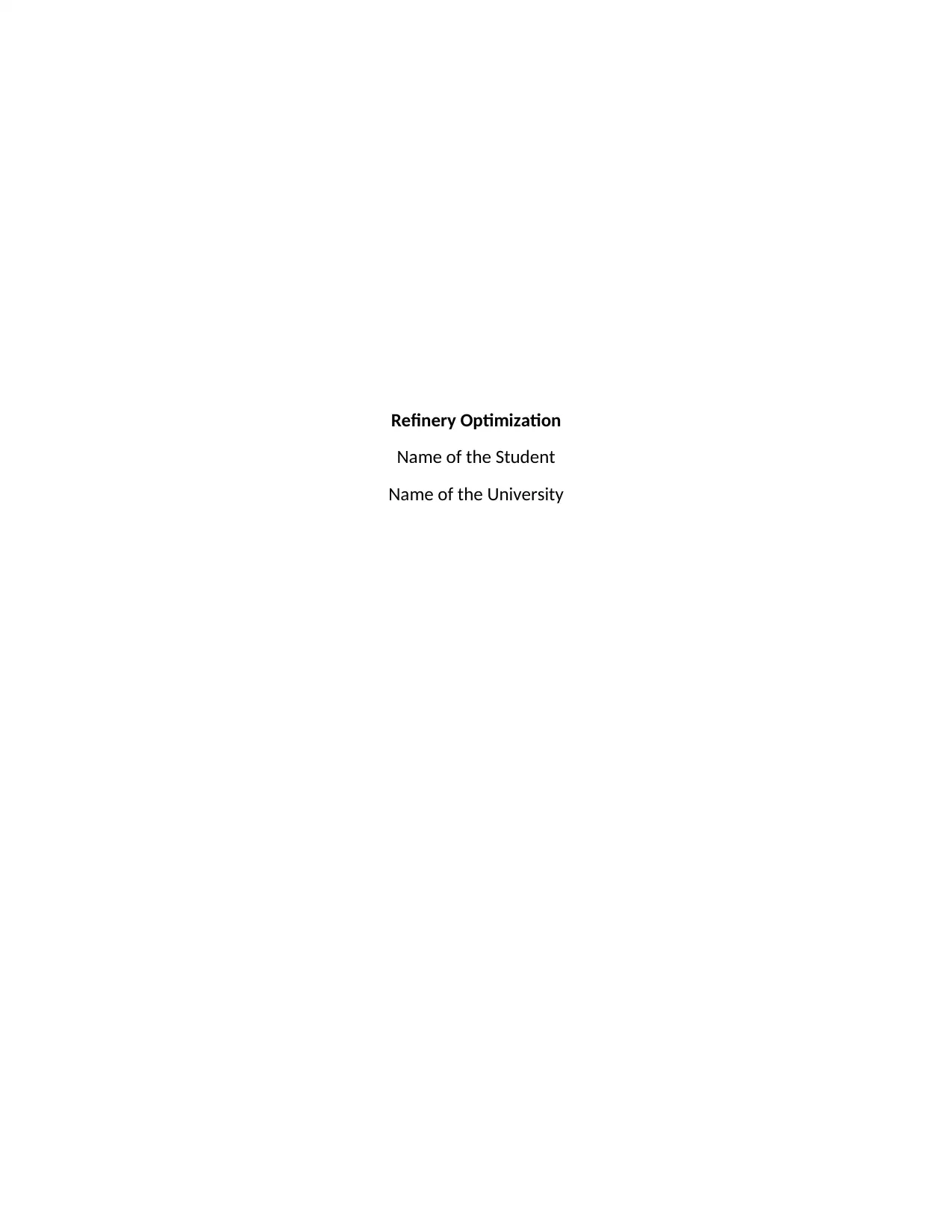
Refinery Optimization
Name of the Student
Name of the University
Name of the Student
Name of the University
Secure Best Marks with AI Grader
Need help grading? Try our AI Grader for instant feedback on your assignments.
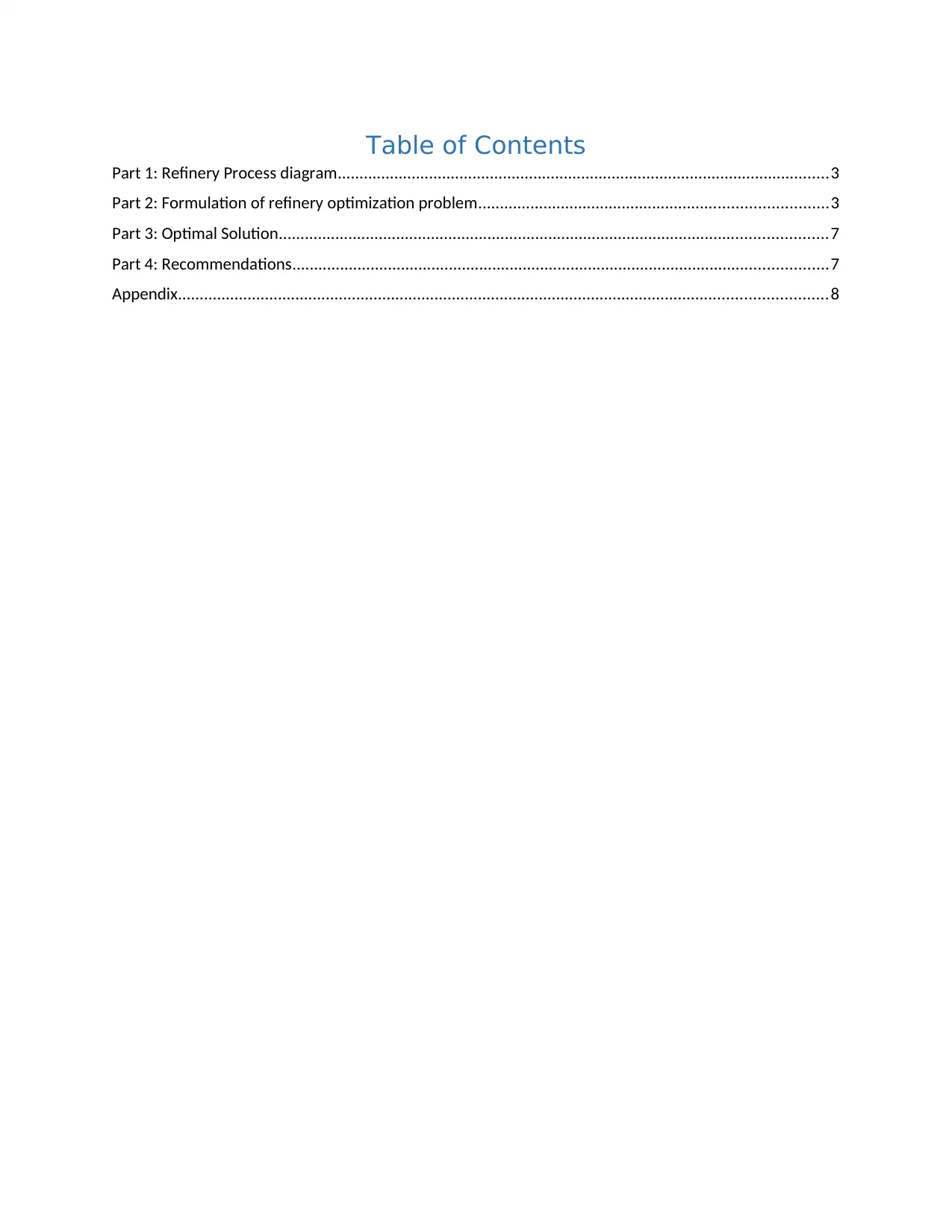
Table of Contents
Part 1: Refinery Process diagram.................................................................................................................3
Part 2: Formulation of refinery optimization problem................................................................................3
Part 3: Optimal Solution..............................................................................................................................7
Part 4: Recommendations...........................................................................................................................7
Appendix.....................................................................................................................................................8
Part 1: Refinery Process diagram.................................................................................................................3
Part 2: Formulation of refinery optimization problem................................................................................3
Part 3: Optimal Solution..............................................................................................................................7
Part 4: Recommendations...........................................................................................................................7
Appendix.....................................................................................................................................................8
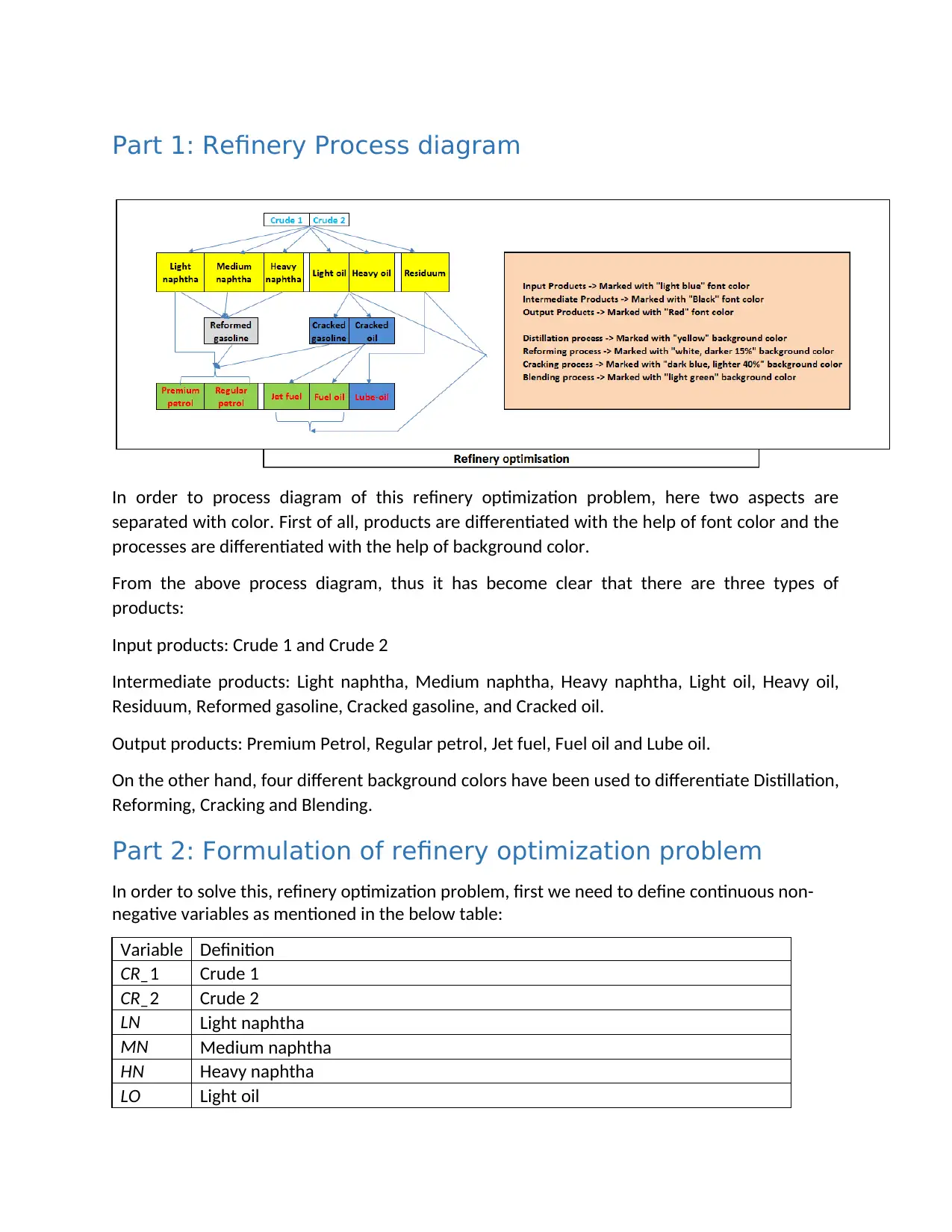
Part 1: Refinery Process diagram
In order to process diagram of this refinery optimization problem, here two aspects are
separated with color. First of all, products are differentiated with the help of font color and the
processes are differentiated with the help of background color.
From the above process diagram, thus it has become clear that there are three types of
products:
Input products: Crude 1 and Crude 2
Intermediate products: Light naphtha, Medium naphtha, Heavy naphtha, Light oil, Heavy oil,
Residuum, Reformed gasoline, Cracked gasoline, and Cracked oil.
Output products: Premium Petrol, Regular petrol, Jet fuel, Fuel oil and Lube oil.
On the other hand, four different background colors have been used to differentiate Distillation,
Reforming, Cracking and Blending.
Part 2: Formulation of refinery optimization problem
In order to solve this, refinery optimization problem, first we need to define continuous non-
negative variables as mentioned in the below table:
Variable Definition
CR_1 Crude 1
CR_2 Crude 2
LN Light naphtha
MN Medium naphtha
HN Heavy naphtha
LO Light oil
In order to process diagram of this refinery optimization problem, here two aspects are
separated with color. First of all, products are differentiated with the help of font color and the
processes are differentiated with the help of background color.
From the above process diagram, thus it has become clear that there are three types of
products:
Input products: Crude 1 and Crude 2
Intermediate products: Light naphtha, Medium naphtha, Heavy naphtha, Light oil, Heavy oil,
Residuum, Reformed gasoline, Cracked gasoline, and Cracked oil.
Output products: Premium Petrol, Regular petrol, Jet fuel, Fuel oil and Lube oil.
On the other hand, four different background colors have been used to differentiate Distillation,
Reforming, Cracking and Blending.
Part 2: Formulation of refinery optimization problem
In order to solve this, refinery optimization problem, first we need to define continuous non-
negative variables as mentioned in the below table:
Variable Definition
CR_1 Crude 1
CR_2 Crude 2
LN Light naphtha
MN Medium naphtha
HN Heavy naphtha
LO Light oil
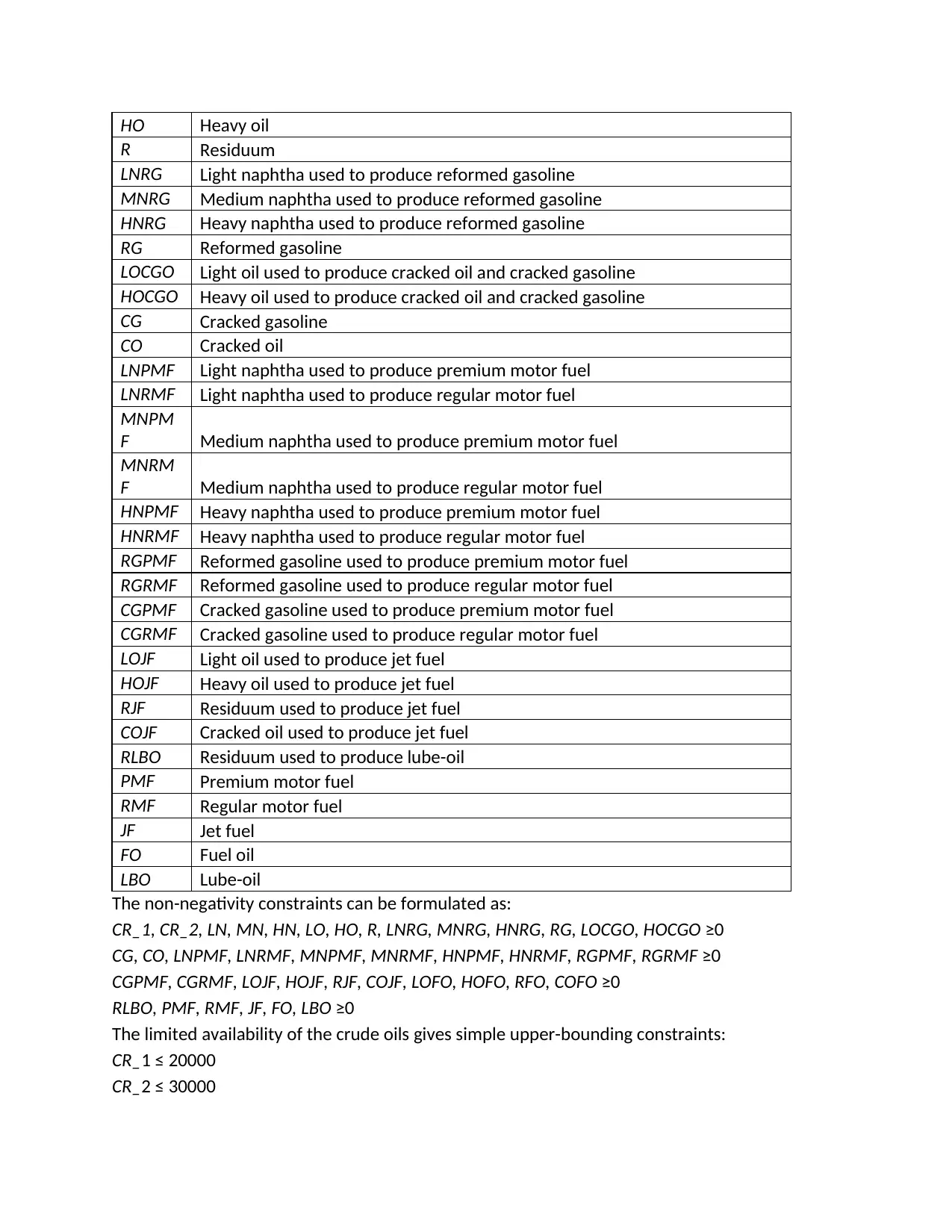
HO Heavy oil
R Residuum
LNRG Light naphtha used to produce reformed gasoline
MNRG Medium naphtha used to produce reformed gasoline
HNRG Heavy naphtha used to produce reformed gasoline
RG Reformed gasoline
LOCGO Light oil used to produce cracked oil and cracked gasoline
HOCGO Heavy oil used to produce cracked oil and cracked gasoline
CG Cracked gasoline
CO Cracked oil
LNPMF Light naphtha used to produce premium motor fuel
LNRMF Light naphtha used to produce regular motor fuel
MNPM
F Medium naphtha used to produce premium motor fuel
MNRM
F Medium naphtha used to produce regular motor fuel
HNPMF Heavy naphtha used to produce premium motor fuel
HNRMF Heavy naphtha used to produce regular motor fuel
RGPMF Reformed gasoline used to produce premium motor fuel
RGRMF Reformed gasoline used to produce regular motor fuel
CGPMF Cracked gasoline used to produce premium motor fuel
CGRMF Cracked gasoline used to produce regular motor fuel
LOJF Light oil used to produce jet fuel
HOJF Heavy oil used to produce jet fuel
RJF Residuum used to produce jet fuel
COJF Cracked oil used to produce jet fuel
RLBO Residuum used to produce lube-oil
PMF Premium motor fuel
RMF Regular motor fuel
JF Jet fuel
FO Fuel oil
LBO Lube-oil
The non-negativity constraints can be formulated as:
CR_1, CR_2, LN, MN, HN, LO, HO, R, LNRG, MNRG, HNRG, RG, LOCGO, HOCGO ≥0
CG, CO, LNPMF, LNRMF, MNPMF, MNRMF, HNPMF, HNRMF, RGPMF, RGRMF ≥0
CGPMF, CGRMF, LOJF, HOJF, RJF, COJF, LOFO, HOFO, RFO, COFO ≥0
RLBO, PMF, RMF, JF, FO, LBO ≥0
The limited availability of the crude oils gives simple upper-bounding constraints:
CR_1 ≤ 20000
CR_2 ≤ 30000
R Residuum
LNRG Light naphtha used to produce reformed gasoline
MNRG Medium naphtha used to produce reformed gasoline
HNRG Heavy naphtha used to produce reformed gasoline
RG Reformed gasoline
LOCGO Light oil used to produce cracked oil and cracked gasoline
HOCGO Heavy oil used to produce cracked oil and cracked gasoline
CG Cracked gasoline
CO Cracked oil
LNPMF Light naphtha used to produce premium motor fuel
LNRMF Light naphtha used to produce regular motor fuel
MNPM
F Medium naphtha used to produce premium motor fuel
MNRM
F Medium naphtha used to produce regular motor fuel
HNPMF Heavy naphtha used to produce premium motor fuel
HNRMF Heavy naphtha used to produce regular motor fuel
RGPMF Reformed gasoline used to produce premium motor fuel
RGRMF Reformed gasoline used to produce regular motor fuel
CGPMF Cracked gasoline used to produce premium motor fuel
CGRMF Cracked gasoline used to produce regular motor fuel
LOJF Light oil used to produce jet fuel
HOJF Heavy oil used to produce jet fuel
RJF Residuum used to produce jet fuel
COJF Cracked oil used to produce jet fuel
RLBO Residuum used to produce lube-oil
PMF Premium motor fuel
RMF Regular motor fuel
JF Jet fuel
FO Fuel oil
LBO Lube-oil
The non-negativity constraints can be formulated as:
CR_1, CR_2, LN, MN, HN, LO, HO, R, LNRG, MNRG, HNRG, RG, LOCGO, HOCGO ≥0
CG, CO, LNPMF, LNRMF, MNPMF, MNRMF, HNPMF, HNRMF, RGPMF, RGRMF ≥0
CGPMF, CGRMF, LOJF, HOJF, RJF, COJF, LOFO, HOFO, RFO, COFO ≥0
RLBO, PMF, RMF, JF, FO, LBO ≥0
The limited availability of the crude oils gives simple upper-bounding constraints:
CR_1 ≤ 20000
CR_2 ≤ 30000
Secure Best Marks with AI Grader
Need help grading? Try our AI Grader for instant feedback on your assignments.
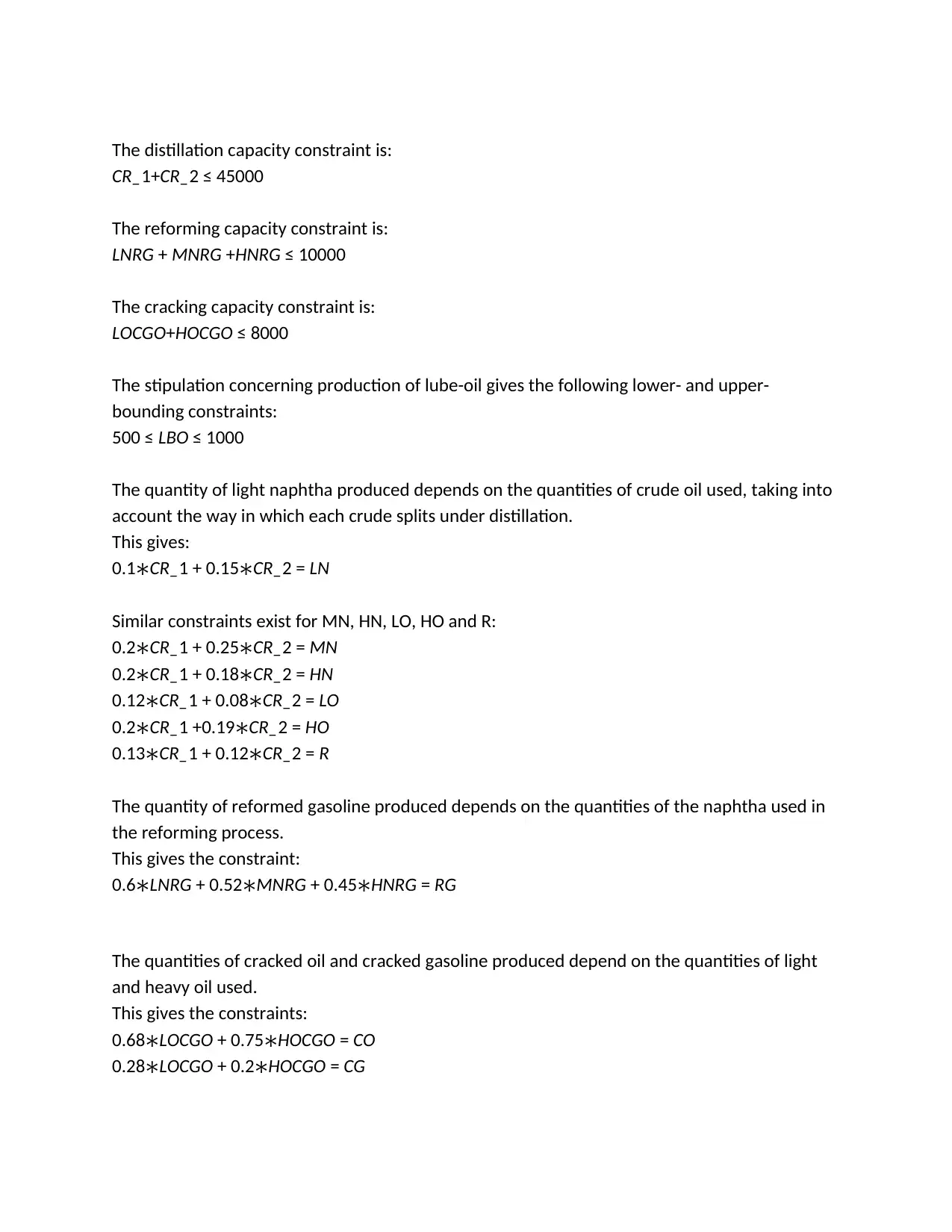
The distillation capacity constraint is:
CR_1+CR_2 ≤ 45000
The reforming capacity constraint is:
LNRG + MNRG +HNRG ≤ 10000
The cracking capacity constraint is:
LOCGO+HOCGO ≤ 8000
The stipulation concerning production of lube-oil gives the following lower- and upper-
bounding constraints:
500 ≤ LBO ≤ 1000
The quantity of light naphtha produced depends on the quantities of crude oil used, taking into
account the way in which each crude splits under distillation.
This gives:
0.1∗CR_1 + 0.15∗CR_2 = LN
Similar constraints exist for MN, HN, LO, HO and R:
0.2∗CR_1 + 0.25∗CR_2 = MN
0.2∗CR_1 + 0.18∗CR_2 = HN
0.12∗CR_1 + 0.08∗CR_2 = LO
0.2∗CR_1 +0.19∗CR_2 = HO
0.13∗CR_1 + 0.12∗CR_2 = R
The quantity of reformed gasoline produced depends on the quantities of the naphtha used in
the reforming process.
This gives the constraint:
0.6∗LNRG + 0.52∗MNRG + 0.45∗HNRG = RG
The quantities of cracked oil and cracked gasoline produced depend on the quantities of light
and heavy oil used.
This gives the constraints:
0.68∗LOCGO + 0.75∗HOCGO = CO
0.28∗LOCGO + 0.2∗HOCGO = CG
CR_1+CR_2 ≤ 45000
The reforming capacity constraint is:
LNRG + MNRG +HNRG ≤ 10000
The cracking capacity constraint is:
LOCGO+HOCGO ≤ 8000
The stipulation concerning production of lube-oil gives the following lower- and upper-
bounding constraints:
500 ≤ LBO ≤ 1000
The quantity of light naphtha produced depends on the quantities of crude oil used, taking into
account the way in which each crude splits under distillation.
This gives:
0.1∗CR_1 + 0.15∗CR_2 = LN
Similar constraints exist for MN, HN, LO, HO and R:
0.2∗CR_1 + 0.25∗CR_2 = MN
0.2∗CR_1 + 0.18∗CR_2 = HN
0.12∗CR_1 + 0.08∗CR_2 = LO
0.2∗CR_1 +0.19∗CR_2 = HO
0.13∗CR_1 + 0.12∗CR_2 = R
The quantity of reformed gasoline produced depends on the quantities of the naphtha used in
the reforming process.
This gives the constraint:
0.6∗LNRG + 0.52∗MNRG + 0.45∗HNRG = RG
The quantities of cracked oil and cracked gasoline produced depend on the quantities of light
and heavy oil used.
This gives the constraints:
0.68∗LOCGO + 0.75∗HOCGO = CO
0.28∗LOCGO + 0.2∗HOCGO = CG
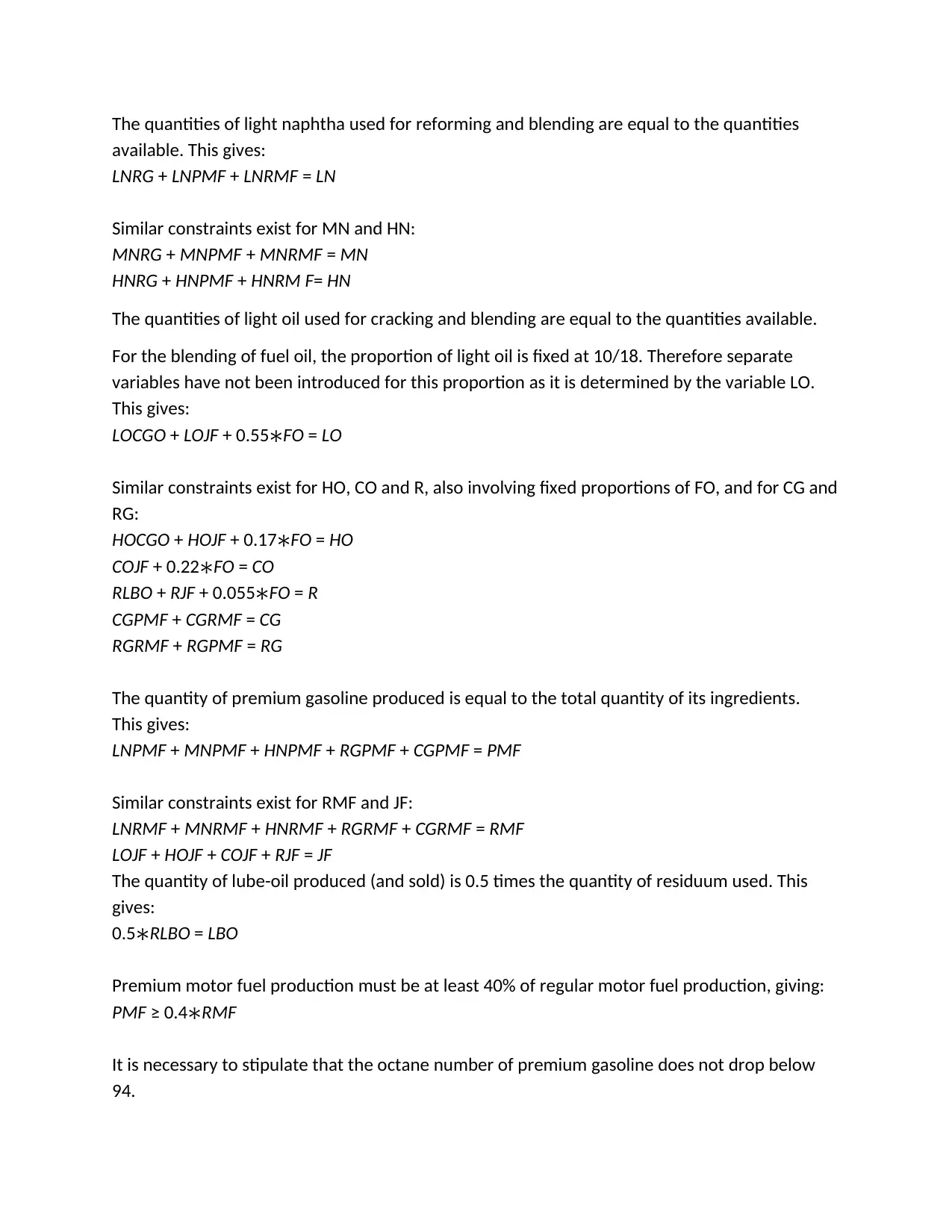
The quantities of light naphtha used for reforming and blending are equal to the quantities
available. This gives:
LNRG + LNPMF + LNRMF = LN
Similar constraints exist for MN and HN:
MNRG + MNPMF + MNRMF = MN
HNRG + HNPMF + HNRM F= HN
The quantities of light oil used for cracking and blending are equal to the quantities available.
For the blending of fuel oil, the proportion of light oil is fixed at 10/18. Therefore separate
variables have not been introduced for this proportion as it is determined by the variable LO.
This gives:
LOCGO + LOJF + 0.55∗FO = LO
Similar constraints exist for HO, CO and R, also involving fixed proportions of FO, and for CG and
RG:
HOCGO + HOJF + 0.17∗FO = HO
COJF + 0.22∗FO = CO
RLBO + RJF + 0.055∗FO = R
CGPMF + CGRMF = CG
RGRMF + RGPMF = RG
The quantity of premium gasoline produced is equal to the total quantity of its ingredients.
This gives:
LNPMF + MNPMF + HNPMF + RGPMF + CGPMF = PMF
Similar constraints exist for RMF and JF:
LNRMF + MNRMF + HNRMF + RGRMF + CGRMF = RMF
LOJF + HOJF + COJF + RJF = JF
The quantity of lube-oil produced (and sold) is 0.5 times the quantity of residuum used. This
gives:
0.5∗RLBO = LBO
Premium motor fuel production must be at least 40% of regular motor fuel production, giving:
PMF ≥ 0.4∗RMF
It is necessary to stipulate that the octane number of premium gasoline does not drop below
94.
available. This gives:
LNRG + LNPMF + LNRMF = LN
Similar constraints exist for MN and HN:
MNRG + MNPMF + MNRMF = MN
HNRG + HNPMF + HNRM F= HN
The quantities of light oil used for cracking and blending are equal to the quantities available.
For the blending of fuel oil, the proportion of light oil is fixed at 10/18. Therefore separate
variables have not been introduced for this proportion as it is determined by the variable LO.
This gives:
LOCGO + LOJF + 0.55∗FO = LO
Similar constraints exist for HO, CO and R, also involving fixed proportions of FO, and for CG and
RG:
HOCGO + HOJF + 0.17∗FO = HO
COJF + 0.22∗FO = CO
RLBO + RJF + 0.055∗FO = R
CGPMF + CGRMF = CG
RGRMF + RGPMF = RG
The quantity of premium gasoline produced is equal to the total quantity of its ingredients.
This gives:
LNPMF + MNPMF + HNPMF + RGPMF + CGPMF = PMF
Similar constraints exist for RMF and JF:
LNRMF + MNRMF + HNRMF + RGRMF + CGRMF = RMF
LOJF + HOJF + COJF + RJF = JF
The quantity of lube-oil produced (and sold) is 0.5 times the quantity of residuum used. This
gives:
0.5∗RLBO = LBO
Premium motor fuel production must be at least 40% of regular motor fuel production, giving:
PMF ≥ 0.4∗RMF
It is necessary to stipulate that the octane number of premium gasoline does not drop below
94.
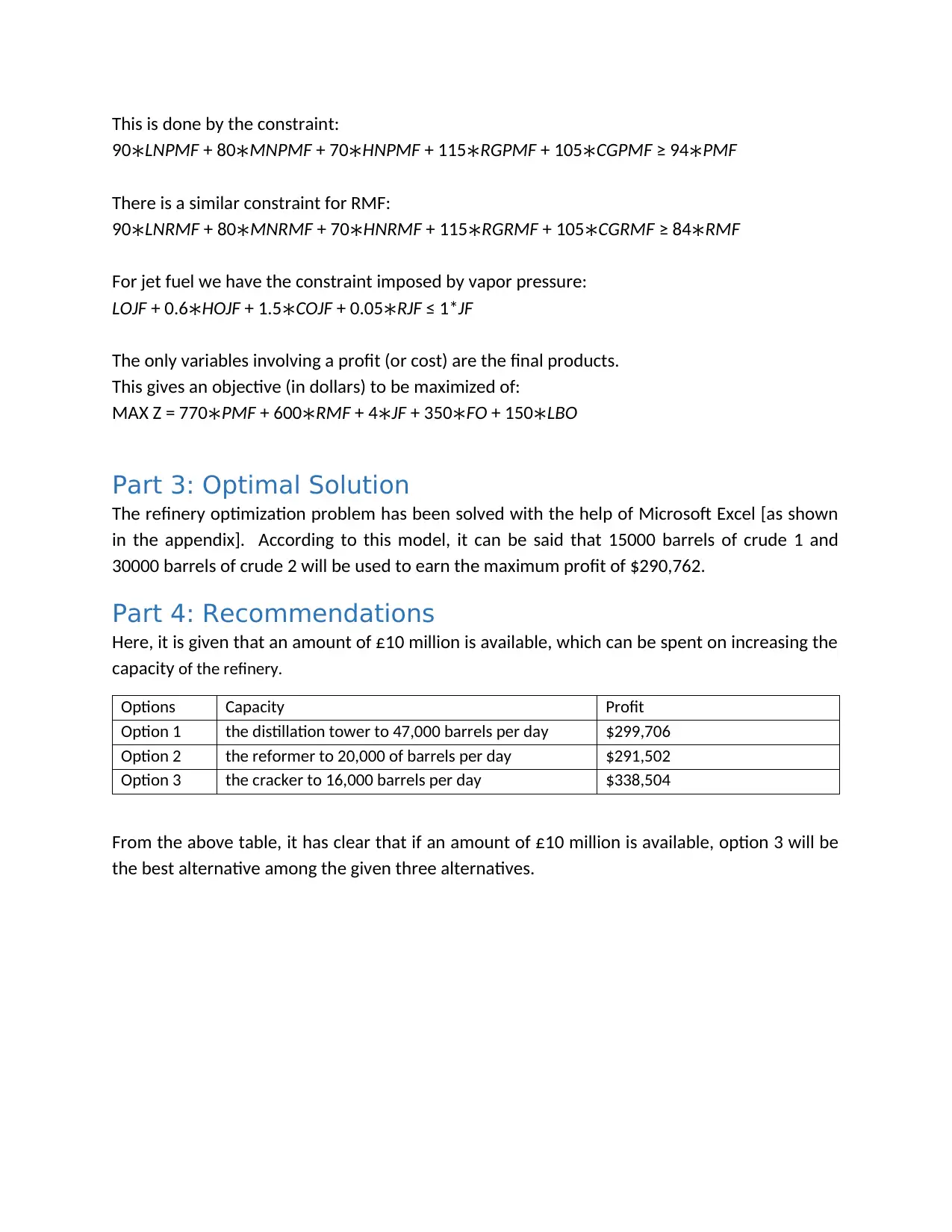
This is done by the constraint:
90∗LNPMF + 80∗MNPMF + 70∗HNPMF + 115∗RGPMF + 105∗CGPMF ≥ 94∗PMF
There is a similar constraint for RMF:
90∗LNRMF + 80∗MNRMF + 70∗HNRMF + 115∗RGRMF + 105∗CGRMF ≥ 84∗RMF
For jet fuel we have the constraint imposed by vapor pressure:
LOJF + 0.6∗HOJF + 1.5∗COJF + 0.05∗RJF ≤ 1*JF
The only variables involving a profit (or cost) are the final products.
This gives an objective (in dollars) to be maximized of:
MAX Z = 770∗PMF + 600∗RMF + 4∗JF + 350∗FO + 150∗LBO
Part 3: Optimal Solution
The refinery optimization problem has been solved with the help of Microsoft Excel [as shown
in the appendix]. According to this model, it can be said that 15000 barrels of crude 1 and
30000 barrels of crude 2 will be used to earn the maximum profit of $290,762.
Part 4: Recommendations
Here, it is given that an amount of £10 million is available, which can be spent on increasing the
capacity of the refinery.
Options Capacity Profit
Option 1 the distillation tower to 47,000 barrels per day $299,706
Option 2 the reformer to 20,000 of barrels per day $291,502
Option 3 the cracker to 16,000 barrels per day $338,504
From the above table, it has clear that if an amount of £10 million is available, option 3 will be
the best alternative among the given three alternatives.
90∗LNPMF + 80∗MNPMF + 70∗HNPMF + 115∗RGPMF + 105∗CGPMF ≥ 94∗PMF
There is a similar constraint for RMF:
90∗LNRMF + 80∗MNRMF + 70∗HNRMF + 115∗RGRMF + 105∗CGRMF ≥ 84∗RMF
For jet fuel we have the constraint imposed by vapor pressure:
LOJF + 0.6∗HOJF + 1.5∗COJF + 0.05∗RJF ≤ 1*JF
The only variables involving a profit (or cost) are the final products.
This gives an objective (in dollars) to be maximized of:
MAX Z = 770∗PMF + 600∗RMF + 4∗JF + 350∗FO + 150∗LBO
Part 3: Optimal Solution
The refinery optimization problem has been solved with the help of Microsoft Excel [as shown
in the appendix]. According to this model, it can be said that 15000 barrels of crude 1 and
30000 barrels of crude 2 will be used to earn the maximum profit of $290,762.
Part 4: Recommendations
Here, it is given that an amount of £10 million is available, which can be spent on increasing the
capacity of the refinery.
Options Capacity Profit
Option 1 the distillation tower to 47,000 barrels per day $299,706
Option 2 the reformer to 20,000 of barrels per day $291,502
Option 3 the cracker to 16,000 barrels per day $338,504
From the above table, it has clear that if an amount of £10 million is available, option 3 will be
the best alternative among the given three alternatives.
Paraphrase This Document
Need a fresh take? Get an instant paraphrase of this document with our AI Paraphraser
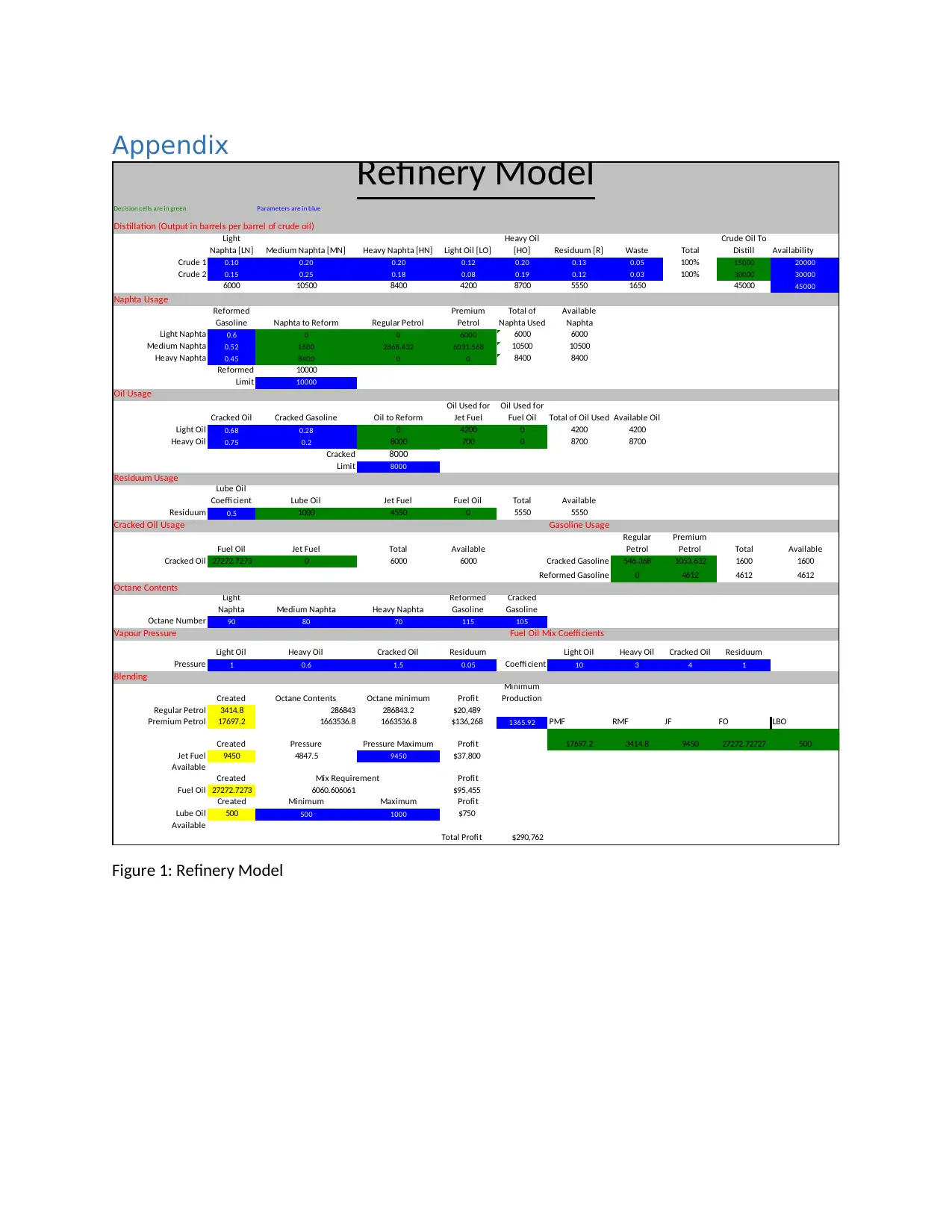
Appendix
Decision cells are in green Parameters are in blue
Distillation (Output in barrels per barrel of crude oil)
Light
Naphta [LN] Medium Naphta [MN] Heavy Naphta [HN] Light Oil [LO]
Heavy Oil
[HO] Residuum [R] Waste Total
Crude Oil To
Distill Availability
Crude 1 0.10 0.20 0.20 0.12 0.20 0.13 0.05 100% 15000 20000
Crude 2 0.15 0.25 0.18 0.08 0.19 0.12 0.03 100% 30000 30000
6000 10500 8400 4200 8700 5550 1650 45000 45000
Naphta Usage
Reformed
Gasoline Naphta to Reform Regular Petrol
Premium
Petrol
Total of
Naphta Used
Available
Naphta
Light Naphta 0.6 0 0 6000 6000 6000
Medium Naphta 0.52 1600 2868.432 6031.568 10500 10500
Heavy Naphta 0.45 8400 0 0 8400 8400
Reformed 10000
Limit 10000
Oil Usage
Cracked Oil Cracked Gasoline Oil to Reform
Oil Used for
Jet Fuel
Oil Used for
Fuel Oil Total of Oil Used Available Oil
Light Oil 0.68 0.28 0 4200 0 4200 4200
Heavy Oil 0.75 0.2 8000 700 0 8700 8700
Cracked 8000
Limit 8000
Residuum Usage
Lube Oil
Coeffi cient Lube Oil Jet Fuel Fuel Oil Total Available
Residuum 0.5 1000 4550 0 5550 5550
Cracked Oil Usage Gasoline Usage
Fuel Oil Jet Fuel Total Available
Regular
Petrol
Premium
Petrol Total Available
Cracked Oil 27272.7273 0 6000 6000 Cracked Gasoline 546.368 1053.632 1600 1600
Reformed Gasoline 0 4612 4612 4612
Octane Contents
Light
Naphta Medium Naphta Heavy Naphta
Reformed
Gasoline
Cracked
Gasoline
Octane Number 90 80 70 115 105
Vapour Pressure Fuel Oil Mix Coefficients
Light Oil Heavy Oil Cracked Oil Residuum Light Oil Heavy Oil Cracked Oil Residuum
Pressure 1 0.6 1.5 0.05 Coeffi cient 10 3 4 1
Blending
Created Octane Contents Octane minimum Profit
Minimum
Production
Regular Petrol 3414.8 286843 286843.2 $20,489
Premium Petrol 17697.2 1663536.8 1663536.8 $136,268 1365.92 PMF RMF JF FO LBO
Created Pressure Pressure Maximum Profit 17697.2 3414.8 9450 27272.72727 500
Jet Fuel 9450 4847.5 9450 $37,800
Available
Created Mix Requirement Profit
Fuel Oil 27272.7273 6060.606061 $95,455
Created Minimum Maximum Profit
Lube Oil 500 500 1000 $750
Available
Total Profit $290,762
Refinery Model
Figure 1: Refinery Model
Decision cells are in green Parameters are in blue
Distillation (Output in barrels per barrel of crude oil)
Light
Naphta [LN] Medium Naphta [MN] Heavy Naphta [HN] Light Oil [LO]
Heavy Oil
[HO] Residuum [R] Waste Total
Crude Oil To
Distill Availability
Crude 1 0.10 0.20 0.20 0.12 0.20 0.13 0.05 100% 15000 20000
Crude 2 0.15 0.25 0.18 0.08 0.19 0.12 0.03 100% 30000 30000
6000 10500 8400 4200 8700 5550 1650 45000 45000
Naphta Usage
Reformed
Gasoline Naphta to Reform Regular Petrol
Premium
Petrol
Total of
Naphta Used
Available
Naphta
Light Naphta 0.6 0 0 6000 6000 6000
Medium Naphta 0.52 1600 2868.432 6031.568 10500 10500
Heavy Naphta 0.45 8400 0 0 8400 8400
Reformed 10000
Limit 10000
Oil Usage
Cracked Oil Cracked Gasoline Oil to Reform
Oil Used for
Jet Fuel
Oil Used for
Fuel Oil Total of Oil Used Available Oil
Light Oil 0.68 0.28 0 4200 0 4200 4200
Heavy Oil 0.75 0.2 8000 700 0 8700 8700
Cracked 8000
Limit 8000
Residuum Usage
Lube Oil
Coeffi cient Lube Oil Jet Fuel Fuel Oil Total Available
Residuum 0.5 1000 4550 0 5550 5550
Cracked Oil Usage Gasoline Usage
Fuel Oil Jet Fuel Total Available
Regular
Petrol
Premium
Petrol Total Available
Cracked Oil 27272.7273 0 6000 6000 Cracked Gasoline 546.368 1053.632 1600 1600
Reformed Gasoline 0 4612 4612 4612
Octane Contents
Light
Naphta Medium Naphta Heavy Naphta
Reformed
Gasoline
Cracked
Gasoline
Octane Number 90 80 70 115 105
Vapour Pressure Fuel Oil Mix Coefficients
Light Oil Heavy Oil Cracked Oil Residuum Light Oil Heavy Oil Cracked Oil Residuum
Pressure 1 0.6 1.5 0.05 Coeffi cient 10 3 4 1
Blending
Created Octane Contents Octane minimum Profit
Minimum
Production
Regular Petrol 3414.8 286843 286843.2 $20,489
Premium Petrol 17697.2 1663536.8 1663536.8 $136,268 1365.92 PMF RMF JF FO LBO
Created Pressure Pressure Maximum Profit 17697.2 3414.8 9450 27272.72727 500
Jet Fuel 9450 4847.5 9450 $37,800
Available
Created Mix Requirement Profit
Fuel Oil 27272.7273 6060.606061 $95,455
Created Minimum Maximum Profit
Lube Oil 500 500 1000 $750
Available
Total Profit $290,762
Refinery Model
Figure 1: Refinery Model
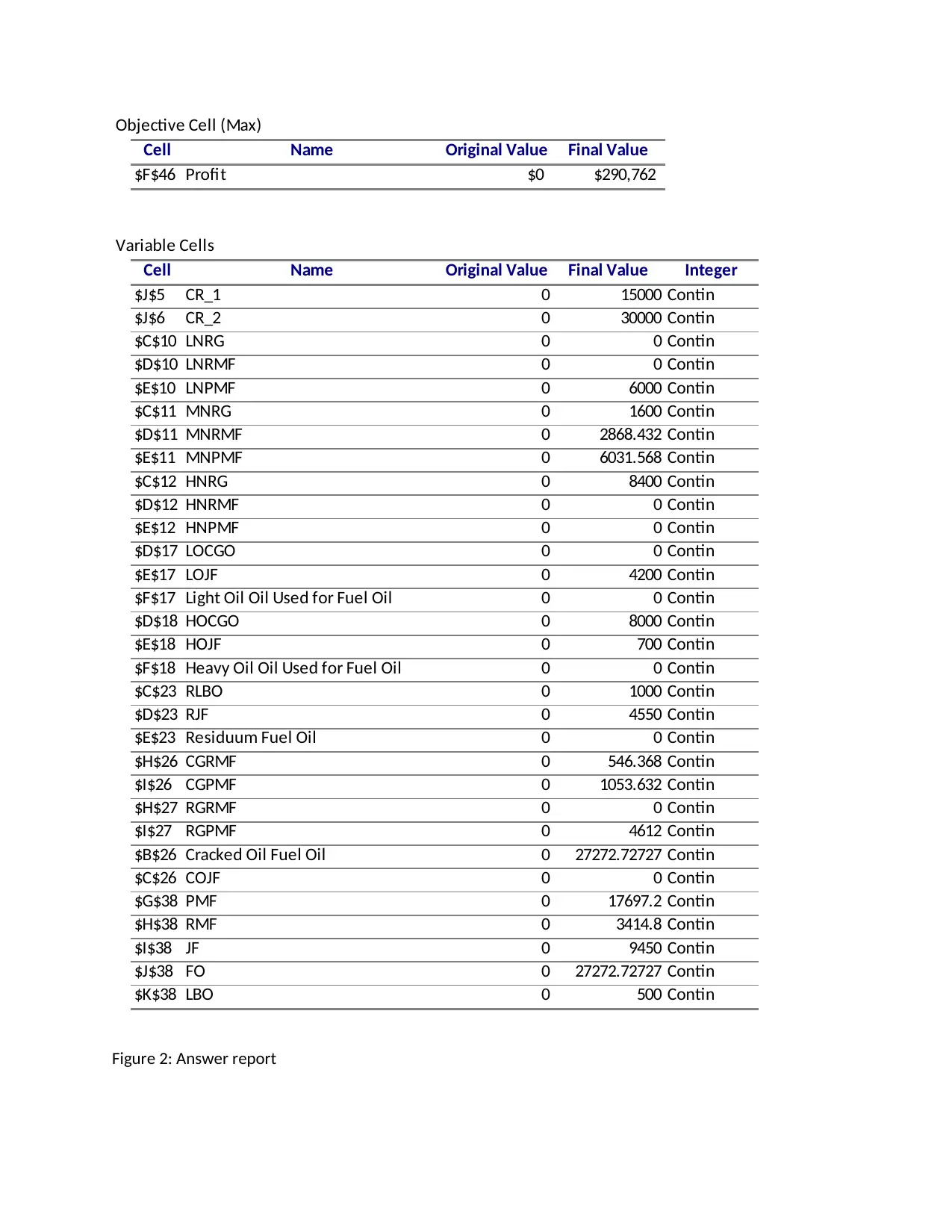
Solver Options
Max Time Unlimited, Iterations Unlimited, Precision 0.000001
Max Subproblems Unlimited, Max Integer Sols Unlimited, Integer Tolerance 1%, Assume NonNegative
Objective Cell (Max)
Cell Name Original Value Final Value
$F$46 Profit $0 $290,762
Variable Cells
Cell Name Original Value Final Value Integer
$J$5 CR_1 0 15000 Contin
$J$6 CR_2 0 30000 Contin
$C$10 LNRG 0 0 Contin
$D$10 LNRMF 0 0 Contin
$E$10 LNPMF 0 6000 Contin
$C$11 MNRG 0 1600 Contin
$D$11 MNRMF 0 2868.432 Contin
$E$11 MNPMF 0 6031.568 Contin
$C$12 HNRG 0 8400 Contin
$D$12 HNRMF 0 0 Contin
$E$12 HNPMF 0 0 Contin
$D$17 LOCGO 0 0 Contin
$E$17 LOJF 0 4200 Contin
$F$17 Light Oil Oil Used for Fuel Oil 0 0 Contin
$D$18 HOCGO 0 8000 Contin
$E$18 HOJF 0 700 Contin
$F$18 Heavy Oil Oil Used for Fuel Oil 0 0 Contin
$C$23 RLBO 0 1000 Contin
$D$23 RJF 0 4550 Contin
$E$23 Residuum Fuel Oil 0 0 Contin
$H$26 CGRMF 0 546.368 Contin
$I$26 CGPMF 0 1053.632 Contin
$H$27 RGRMF 0 0 Contin
$I$27 RGPMF 0 4612 Contin
$B$26 Cracked Oil Fuel Oil 0 27272.72727 Contin
$C$26 COJF 0 0 Contin
$G$38 PMF 0 17697.2 Contin
$H$38 RMF 0 3414.8 Contin
$I$38 JF 0 9450 Contin
$J$38 FO 0 27272.72727 Contin
$K$38 LBO 0 500 Contin
Figure 2: Answer report
Max Time Unlimited, Iterations Unlimited, Precision 0.000001
Max Subproblems Unlimited, Max Integer Sols Unlimited, Integer Tolerance 1%, Assume NonNegative
Objective Cell (Max)
Cell Name Original Value Final Value
$F$46 Profit $0 $290,762
Variable Cells
Cell Name Original Value Final Value Integer
$J$5 CR_1 0 15000 Contin
$J$6 CR_2 0 30000 Contin
$C$10 LNRG 0 0 Contin
$D$10 LNRMF 0 0 Contin
$E$10 LNPMF 0 6000 Contin
$C$11 MNRG 0 1600 Contin
$D$11 MNRMF 0 2868.432 Contin
$E$11 MNPMF 0 6031.568 Contin
$C$12 HNRG 0 8400 Contin
$D$12 HNRMF 0 0 Contin
$E$12 HNPMF 0 0 Contin
$D$17 LOCGO 0 0 Contin
$E$17 LOJF 0 4200 Contin
$F$17 Light Oil Oil Used for Fuel Oil 0 0 Contin
$D$18 HOCGO 0 8000 Contin
$E$18 HOJF 0 700 Contin
$F$18 Heavy Oil Oil Used for Fuel Oil 0 0 Contin
$C$23 RLBO 0 1000 Contin
$D$23 RJF 0 4550 Contin
$E$23 Residuum Fuel Oil 0 0 Contin
$H$26 CGRMF 0 546.368 Contin
$I$26 CGPMF 0 1053.632 Contin
$H$27 RGRMF 0 0 Contin
$I$27 RGPMF 0 4612 Contin
$B$26 Cracked Oil Fuel Oil 0 27272.72727 Contin
$C$26 COJF 0 0 Contin
$G$38 PMF 0 17697.2 Contin
$H$38 RMF 0 3414.8 Contin
$I$38 JF 0 9450 Contin
$J$38 FO 0 27272.72727 Contin
$K$38 LBO 0 500 Contin
Figure 2: Answer report
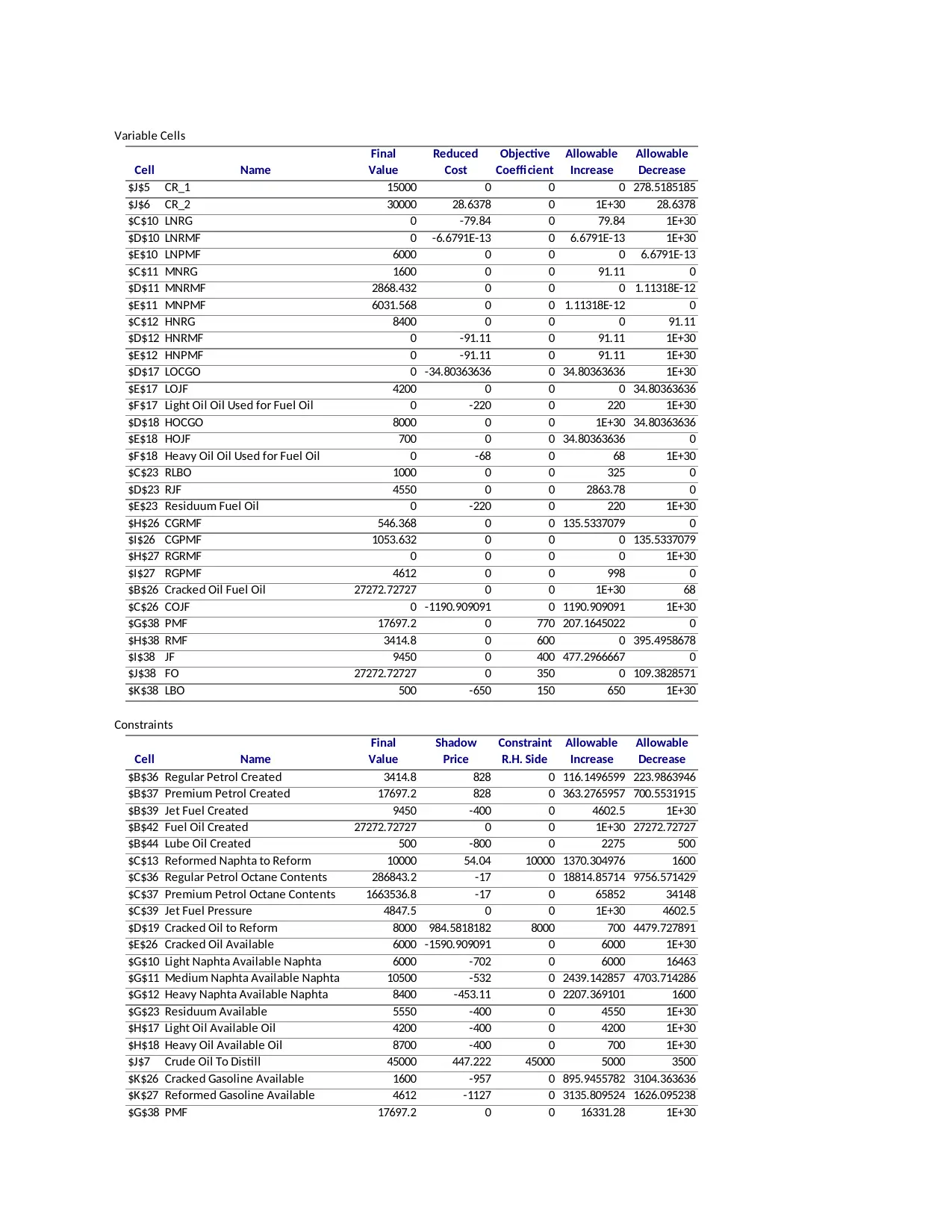
Variable Cells
Final Reduced Objective Allowable Allowable
Cell Name Value Cost Coefficient Increase Decrease
$J$5 CR_1 15000 0 0 0 278.5185185
$J$6 CR_2 30000 28.6378 0 1E+30 28.6378
$C$10 LNRG 0 -79.84 0 79.84 1E+30
$D$10 LNRMF 0 -6.6791E-13 0 6.6791E-13 1E+30
$E$10 LNPMF 6000 0 0 0 6.6791E-13
$C$11 MNRG 1600 0 0 91.11 0
$D$11 MNRMF 2868.432 0 0 0 1.11318E-12
$E$11 MNPMF 6031.568 0 0 1.11318E-12 0
$C$12 HNRG 8400 0 0 0 91.11
$D$12 HNRMF 0 -91.11 0 91.11 1E+30
$E$12 HNPMF 0 -91.11 0 91.11 1E+30
$D$17 LOCGO 0 -34.80363636 0 34.80363636 1E+30
$E$17 LOJF 4200 0 0 0 34.80363636
$F$17 Light Oil Oil Used for Fuel Oil 0 -220 0 220 1E+30
$D$18 HOCGO 8000 0 0 1E+30 34.80363636
$E$18 HOJF 700 0 0 34.80363636 0
$F$18 Heavy Oil Oil Used for Fuel Oil 0 -68 0 68 1E+30
$C$23 RLBO 1000 0 0 325 0
$D$23 RJF 4550 0 0 2863.78 0
$E$23 Residuum Fuel Oil 0 -220 0 220 1E+30
$H$26 CGRMF 546.368 0 0 135.5337079 0
$I$26 CGPMF 1053.632 0 0 0 135.5337079
$H$27 RGRMF 0 0 0 0 1E+30
$I$27 RGPMF 4612 0 0 998 0
$B$26 Cracked Oil Fuel Oil 27272.72727 0 0 1E+30 68
$C$26 COJF 0 -1190.909091 0 1190.909091 1E+30
$G$38 PMF 17697.2 0 770 207.1645022 0
$H$38 RMF 3414.8 0 600 0 395.4958678
$I$38 JF 9450 0 400 477.2966667 0
$J$38 FO 27272.72727 0 350 0 109.3828571
$K$38 LBO 500 -650 150 650 1E+30
Constraints
Final Shadow Constraint Allowable Allowable
Cell Name Value Price R.H. Side Increase Decrease
$B$36 Regular Petrol Created 3414.8 828 0 116.1496599 223.9863946
$B$37 Premium Petrol Created 17697.2 828 0 363.2765957 700.5531915
$B$39 Jet Fuel Created 9450 -400 0 4602.5 1E+30
$B$42 Fuel Oil Created 27272.72727 0 0 1E+30 27272.72727
$B$44 Lube Oil Created 500 -800 0 2275 500
$C$13 Reformed Naphta to Reform 10000 54.04 10000 1370.304976 1600
$C$36 Regular Petrol Octane Contents 286843.2 -17 0 18814.85714 9756.571429
$C$37 Premium Petrol Octane Contents 1663536.8 -17 0 65852 34148
$C$39 Jet Fuel Pressure 4847.5 0 0 1E+30 4602.5
$D$19 Cracked Oil to Reform 8000 984.5818182 8000 700 4479.727891
$E$26 Cracked Oil Available 6000 -1590.909091 0 6000 1E+30
$G$10 Light Naphta Available Naphta 6000 -702 0 6000 16463
$G$11 Medium Naphta Available Naphta 10500 -532 0 2439.142857 4703.714286
$G$12 Heavy Naphta Available Naphta 8400 -453.11 0 2207.369101 1600
$G$23 Residuum Available 5550 -400 0 4550 1E+30
$H$17 Light Oil Available Oil 4200 -400 0 4200 1E+30
$H$18 Heavy Oil Available Oil 8700 -400 0 700 1E+30
$J$7 Crude Oil To Distill 45000 447.222 45000 5000 3500
$K$26 Cracked Gasoline Available 1600 -957 0 895.9455782 3104.363636
$K$27 Reformed Gasoline Available 4612 -1127 0 3135.809524 1626.095238
$G$38 PMF 17697.2 0 0 16331.28 1E+30
Final Reduced Objective Allowable Allowable
Cell Name Value Cost Coefficient Increase Decrease
$J$5 CR_1 15000 0 0 0 278.5185185
$J$6 CR_2 30000 28.6378 0 1E+30 28.6378
$C$10 LNRG 0 -79.84 0 79.84 1E+30
$D$10 LNRMF 0 -6.6791E-13 0 6.6791E-13 1E+30
$E$10 LNPMF 6000 0 0 0 6.6791E-13
$C$11 MNRG 1600 0 0 91.11 0
$D$11 MNRMF 2868.432 0 0 0 1.11318E-12
$E$11 MNPMF 6031.568 0 0 1.11318E-12 0
$C$12 HNRG 8400 0 0 0 91.11
$D$12 HNRMF 0 -91.11 0 91.11 1E+30
$E$12 HNPMF 0 -91.11 0 91.11 1E+30
$D$17 LOCGO 0 -34.80363636 0 34.80363636 1E+30
$E$17 LOJF 4200 0 0 0 34.80363636
$F$17 Light Oil Oil Used for Fuel Oil 0 -220 0 220 1E+30
$D$18 HOCGO 8000 0 0 1E+30 34.80363636
$E$18 HOJF 700 0 0 34.80363636 0
$F$18 Heavy Oil Oil Used for Fuel Oil 0 -68 0 68 1E+30
$C$23 RLBO 1000 0 0 325 0
$D$23 RJF 4550 0 0 2863.78 0
$E$23 Residuum Fuel Oil 0 -220 0 220 1E+30
$H$26 CGRMF 546.368 0 0 135.5337079 0
$I$26 CGPMF 1053.632 0 0 0 135.5337079
$H$27 RGRMF 0 0 0 0 1E+30
$I$27 RGPMF 4612 0 0 998 0
$B$26 Cracked Oil Fuel Oil 27272.72727 0 0 1E+30 68
$C$26 COJF 0 -1190.909091 0 1190.909091 1E+30
$G$38 PMF 17697.2 0 770 207.1645022 0
$H$38 RMF 3414.8 0 600 0 395.4958678
$I$38 JF 9450 0 400 477.2966667 0
$J$38 FO 27272.72727 0 350 0 109.3828571
$K$38 LBO 500 -650 150 650 1E+30
Constraints
Final Shadow Constraint Allowable Allowable
Cell Name Value Price R.H. Side Increase Decrease
$B$36 Regular Petrol Created 3414.8 828 0 116.1496599 223.9863946
$B$37 Premium Petrol Created 17697.2 828 0 363.2765957 700.5531915
$B$39 Jet Fuel Created 9450 -400 0 4602.5 1E+30
$B$42 Fuel Oil Created 27272.72727 0 0 1E+30 27272.72727
$B$44 Lube Oil Created 500 -800 0 2275 500
$C$13 Reformed Naphta to Reform 10000 54.04 10000 1370.304976 1600
$C$36 Regular Petrol Octane Contents 286843.2 -17 0 18814.85714 9756.571429
$C$37 Premium Petrol Octane Contents 1663536.8 -17 0 65852 34148
$C$39 Jet Fuel Pressure 4847.5 0 0 1E+30 4602.5
$D$19 Cracked Oil to Reform 8000 984.5818182 8000 700 4479.727891
$E$26 Cracked Oil Available 6000 -1590.909091 0 6000 1E+30
$G$10 Light Naphta Available Naphta 6000 -702 0 6000 16463
$G$11 Medium Naphta Available Naphta 10500 -532 0 2439.142857 4703.714286
$G$12 Heavy Naphta Available Naphta 8400 -453.11 0 2207.369101 1600
$G$23 Residuum Available 5550 -400 0 4550 1E+30
$H$17 Light Oil Available Oil 4200 -400 0 4200 1E+30
$H$18 Heavy Oil Available Oil 8700 -400 0 700 1E+30
$J$7 Crude Oil To Distill 45000 447.222 45000 5000 3500
$K$26 Cracked Gasoline Available 1600 -957 0 895.9455782 3104.363636
$K$27 Reformed Gasoline Available 4612 -1127 0 3135.809524 1626.095238
$G$38 PMF 17697.2 0 0 16331.28 1E+30
Secure Best Marks with AI Grader
Need help grading? Try our AI Grader for instant feedback on your assignments.
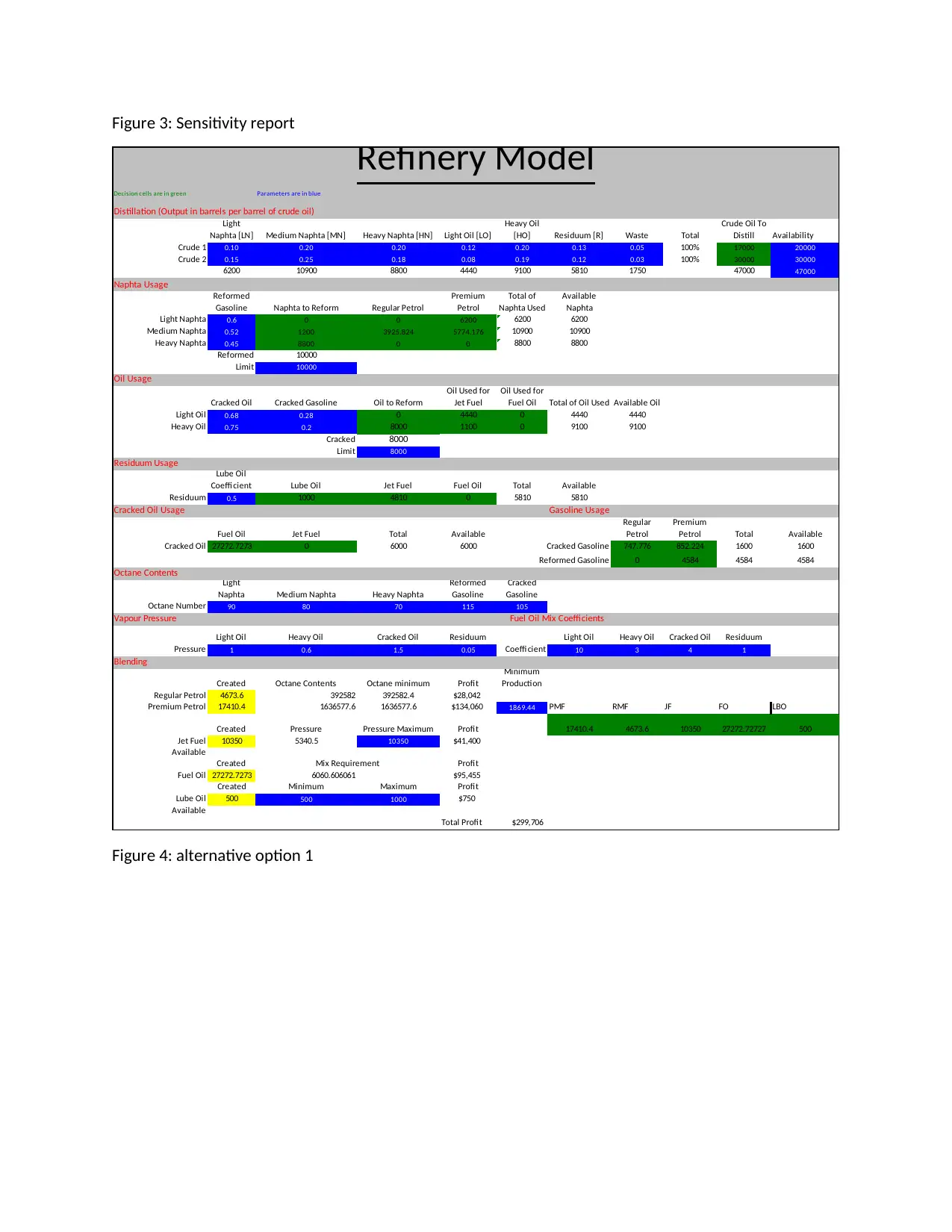
Figure 3: Sensitivity report
Decision cells are in green Parameters are in blue
Distillation (Output in barrels per barrel of crude oil)
Light
Naphta [LN] Medium Naphta [MN] Heavy Naphta [HN] Light Oil [LO]
Heavy Oil
[HO] Residuum [R] Waste Total
Crude Oil To
Distill Availability
Crude 1 0.10 0.20 0.20 0.12 0.20 0.13 0.05 100% 17000 20000
Crude 2 0.15 0.25 0.18 0.08 0.19 0.12 0.03 100% 30000 30000
6200 10900 8800 4440 9100 5810 1750 47000 47000
Naphta Usage
Reformed
Gasoline Naphta to Reform Regular Petrol
Premium
Petrol
Total of
Naphta Used
Available
Naphta
Light Naphta 0.6 0 0 6200 6200 6200
Medium Naphta 0.52 1200 3925.824 5774.176 10900 10900
Heavy Naphta 0.45 8800 0 0 8800 8800
Reformed 10000
Limit 10000
Oil Usage
Cracked Oil Cracked Gasoline Oil to Reform
Oil Used for
Jet Fuel
Oil Used for
Fuel Oil Total of Oil Used Available Oil
Light Oil 0.68 0.28 0 4440 0 4440 4440
Heavy Oil 0.75 0.2 8000 1100 0 9100 9100
Cracked 8000
Limit 8000
Residuum Usage
Lube Oil
Coeffi cient Lube Oil Jet Fuel Fuel Oil Total Available
Residuum 0.5 1000 4810 0 5810 5810
Cracked Oil Usage Gasoline Usage
Fuel Oil Jet Fuel Total Available
Regular
Petrol
Premium
Petrol Total Available
Cracked Oil 27272.7273 0 6000 6000 Cracked Gasoline 747.776 852.224 1600 1600
Reformed Gasoline 0 4584 4584 4584
Octane Contents
Light
Naphta Medium Naphta Heavy Naphta
Reformed
Gasoline
Cracked
Gasoline
Octane Number 90 80 70 115 105
Vapour Pressure Fuel Oil Mix Coefficients
Light Oil Heavy Oil Cracked Oil Residuum Light Oil Heavy Oil Cracked Oil Residuum
Pressure 1 0.6 1.5 0.05 Coeffi cient 10 3 4 1
Blending
Created Octane Contents Octane minimum Profit
Minimum
Production
Regular Petrol 4673.6 392582 392582.4 $28,042
Premium Petrol 17410.4 1636577.6 1636577.6 $134,060 1869.44 PMF RMF JF FO LBO
Created Pressure Pressure Maximum Profit 17410.4 4673.6 10350 27272.72727 500
Jet Fuel 10350 5340.5 10350 $41,400
Available
Created Mix Requirement Profit
Fuel Oil 27272.7273 6060.606061 $95,455
Created Minimum Maximum Profit
Lube Oil 500 500 1000 $750
Available
Total Profit $299,706
Refinery Model
Figure 4: alternative option 1
Decision cells are in green Parameters are in blue
Distillation (Output in barrels per barrel of crude oil)
Light
Naphta [LN] Medium Naphta [MN] Heavy Naphta [HN] Light Oil [LO]
Heavy Oil
[HO] Residuum [R] Waste Total
Crude Oil To
Distill Availability
Crude 1 0.10 0.20 0.20 0.12 0.20 0.13 0.05 100% 17000 20000
Crude 2 0.15 0.25 0.18 0.08 0.19 0.12 0.03 100% 30000 30000
6200 10900 8800 4440 9100 5810 1750 47000 47000
Naphta Usage
Reformed
Gasoline Naphta to Reform Regular Petrol
Premium
Petrol
Total of
Naphta Used
Available
Naphta
Light Naphta 0.6 0 0 6200 6200 6200
Medium Naphta 0.52 1200 3925.824 5774.176 10900 10900
Heavy Naphta 0.45 8800 0 0 8800 8800
Reformed 10000
Limit 10000
Oil Usage
Cracked Oil Cracked Gasoline Oil to Reform
Oil Used for
Jet Fuel
Oil Used for
Fuel Oil Total of Oil Used Available Oil
Light Oil 0.68 0.28 0 4440 0 4440 4440
Heavy Oil 0.75 0.2 8000 1100 0 9100 9100
Cracked 8000
Limit 8000
Residuum Usage
Lube Oil
Coeffi cient Lube Oil Jet Fuel Fuel Oil Total Available
Residuum 0.5 1000 4810 0 5810 5810
Cracked Oil Usage Gasoline Usage
Fuel Oil Jet Fuel Total Available
Regular
Petrol
Premium
Petrol Total Available
Cracked Oil 27272.7273 0 6000 6000 Cracked Gasoline 747.776 852.224 1600 1600
Reformed Gasoline 0 4584 4584 4584
Octane Contents
Light
Naphta Medium Naphta Heavy Naphta
Reformed
Gasoline
Cracked
Gasoline
Octane Number 90 80 70 115 105
Vapour Pressure Fuel Oil Mix Coefficients
Light Oil Heavy Oil Cracked Oil Residuum Light Oil Heavy Oil Cracked Oil Residuum
Pressure 1 0.6 1.5 0.05 Coeffi cient 10 3 4 1
Blending
Created Octane Contents Octane minimum Profit
Minimum
Production
Regular Petrol 4673.6 392582 392582.4 $28,042
Premium Petrol 17410.4 1636577.6 1636577.6 $134,060 1869.44 PMF RMF JF FO LBO
Created Pressure Pressure Maximum Profit 17410.4 4673.6 10350 27272.72727 500
Jet Fuel 10350 5340.5 10350 $41,400
Available
Created Mix Requirement Profit
Fuel Oil 27272.7273 6060.606061 $95,455
Created Minimum Maximum Profit
Lube Oil 500 500 1000 $750
Available
Total Profit $299,706
Refinery Model
Figure 4: alternative option 1
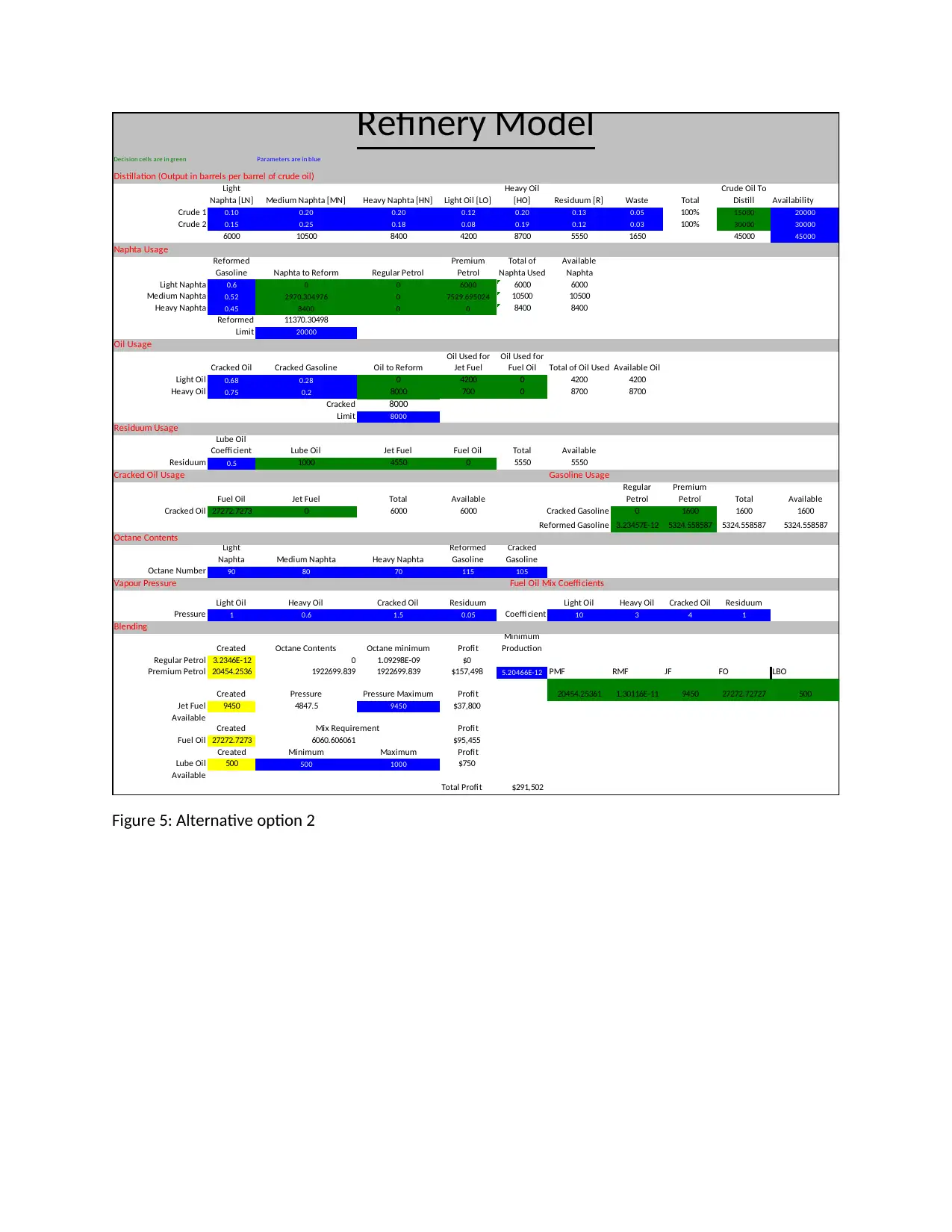
Decision cells are in green Parameters are in blue
Distillation (Output in barrels per barrel of crude oil)
Light
Naphta [LN] Medium Naphta [MN] Heavy Naphta [HN] Light Oil [LO]
Heavy Oil
[HO] Residuum [R] Waste Total
Crude Oil To
Distill Availability
Crude 1 0.10 0.20 0.20 0.12 0.20 0.13 0.05 100% 15000 20000
Crude 2 0.15 0.25 0.18 0.08 0.19 0.12 0.03 100% 30000 30000
6000 10500 8400 4200 8700 5550 1650 45000 45000
Naphta Usage
Reformed
Gasoline Naphta to Reform Regular Petrol
Premium
Petrol
Total of
Naphta Used
Available
Naphta
Light Naphta 0.6 0 0 6000 6000 6000
Medium Naphta 0.52 2970.304976 0 7529.695024 10500 10500
Heavy Naphta 0.45 8400 0 0 8400 8400
Reformed 11370.30498
Limit 20000
Oil Usage
Cracked Oil Cracked Gasoline Oil to Reform
Oil Used for
Jet Fuel
Oil Used for
Fuel Oil Total of Oil Used Available Oil
Light Oil 0.68 0.28 0 4200 0 4200 4200
Heavy Oil 0.75 0.2 8000 700 0 8700 8700
Cracked 8000
Limit 8000
Residuum Usage
Lube Oil
Coeffi cient Lube Oil Jet Fuel Fuel Oil Total Available
Residuum 0.5 1000 4550 0 5550 5550
Cracked Oil Usage Gasoline Usage
Fuel Oil Jet Fuel Total Available
Regular
Petrol
Premium
Petrol Total Available
Cracked Oil 27272.7273 0 6000 6000 Cracked Gasoline 0 1600 1600 1600
Reformed Gasoline 3.23457E-12 5324.558587 5324.558587 5324.558587
Octane Contents
Light
Naphta Medium Naphta Heavy Naphta
Reformed
Gasoline
Cracked
Gasoline
Octane Number 90 80 70 115 105
Vapour Pressure Fuel Oil Mix Coefficients
Light Oil Heavy Oil Cracked Oil Residuum Light Oil Heavy Oil Cracked Oil Residuum
Pressure 1 0.6 1.5 0.05 Coeffi cient 10 3 4 1
Blending
Created Octane Contents Octane minimum Profit
Minimum
Production
Regular Petrol 3.2346E-12 0 1.09298E-09 $0
Premium Petrol 20454.2536 1922699.839 1922699.839 $157,498 5.20466E-12 PMF RMF JF FO LBO
Created Pressure Pressure Maximum Profit 20454.25361 1.30116E-11 9450 27272.72727 500
Jet Fuel 9450 4847.5 9450 $37,800
Available
Created Mix Requirement Profit
Fuel Oil 27272.7273 6060.606061 $95,455
Created Minimum Maximum Profit
Lube Oil 500 500 1000 $750
Available
Total Profit $291,502
Refinery Model
Figure 5: Alternative option 2
Distillation (Output in barrels per barrel of crude oil)
Light
Naphta [LN] Medium Naphta [MN] Heavy Naphta [HN] Light Oil [LO]
Heavy Oil
[HO] Residuum [R] Waste Total
Crude Oil To
Distill Availability
Crude 1 0.10 0.20 0.20 0.12 0.20 0.13 0.05 100% 15000 20000
Crude 2 0.15 0.25 0.18 0.08 0.19 0.12 0.03 100% 30000 30000
6000 10500 8400 4200 8700 5550 1650 45000 45000
Naphta Usage
Reformed
Gasoline Naphta to Reform Regular Petrol
Premium
Petrol
Total of
Naphta Used
Available
Naphta
Light Naphta 0.6 0 0 6000 6000 6000
Medium Naphta 0.52 2970.304976 0 7529.695024 10500 10500
Heavy Naphta 0.45 8400 0 0 8400 8400
Reformed 11370.30498
Limit 20000
Oil Usage
Cracked Oil Cracked Gasoline Oil to Reform
Oil Used for
Jet Fuel
Oil Used for
Fuel Oil Total of Oil Used Available Oil
Light Oil 0.68 0.28 0 4200 0 4200 4200
Heavy Oil 0.75 0.2 8000 700 0 8700 8700
Cracked 8000
Limit 8000
Residuum Usage
Lube Oil
Coeffi cient Lube Oil Jet Fuel Fuel Oil Total Available
Residuum 0.5 1000 4550 0 5550 5550
Cracked Oil Usage Gasoline Usage
Fuel Oil Jet Fuel Total Available
Regular
Petrol
Premium
Petrol Total Available
Cracked Oil 27272.7273 0 6000 6000 Cracked Gasoline 0 1600 1600 1600
Reformed Gasoline 3.23457E-12 5324.558587 5324.558587 5324.558587
Octane Contents
Light
Naphta Medium Naphta Heavy Naphta
Reformed
Gasoline
Cracked
Gasoline
Octane Number 90 80 70 115 105
Vapour Pressure Fuel Oil Mix Coefficients
Light Oil Heavy Oil Cracked Oil Residuum Light Oil Heavy Oil Cracked Oil Residuum
Pressure 1 0.6 1.5 0.05 Coeffi cient 10 3 4 1
Blending
Created Octane Contents Octane minimum Profit
Minimum
Production
Regular Petrol 3.2346E-12 0 1.09298E-09 $0
Premium Petrol 20454.2536 1922699.839 1922699.839 $157,498 5.20466E-12 PMF RMF JF FO LBO
Created Pressure Pressure Maximum Profit 20454.25361 1.30116E-11 9450 27272.72727 500
Jet Fuel 9450 4847.5 9450 $37,800
Available
Created Mix Requirement Profit
Fuel Oil 27272.7273 6060.606061 $95,455
Created Minimum Maximum Profit
Lube Oil 500 500 1000 $750
Available
Total Profit $291,502
Refinery Model
Figure 5: Alternative option 2
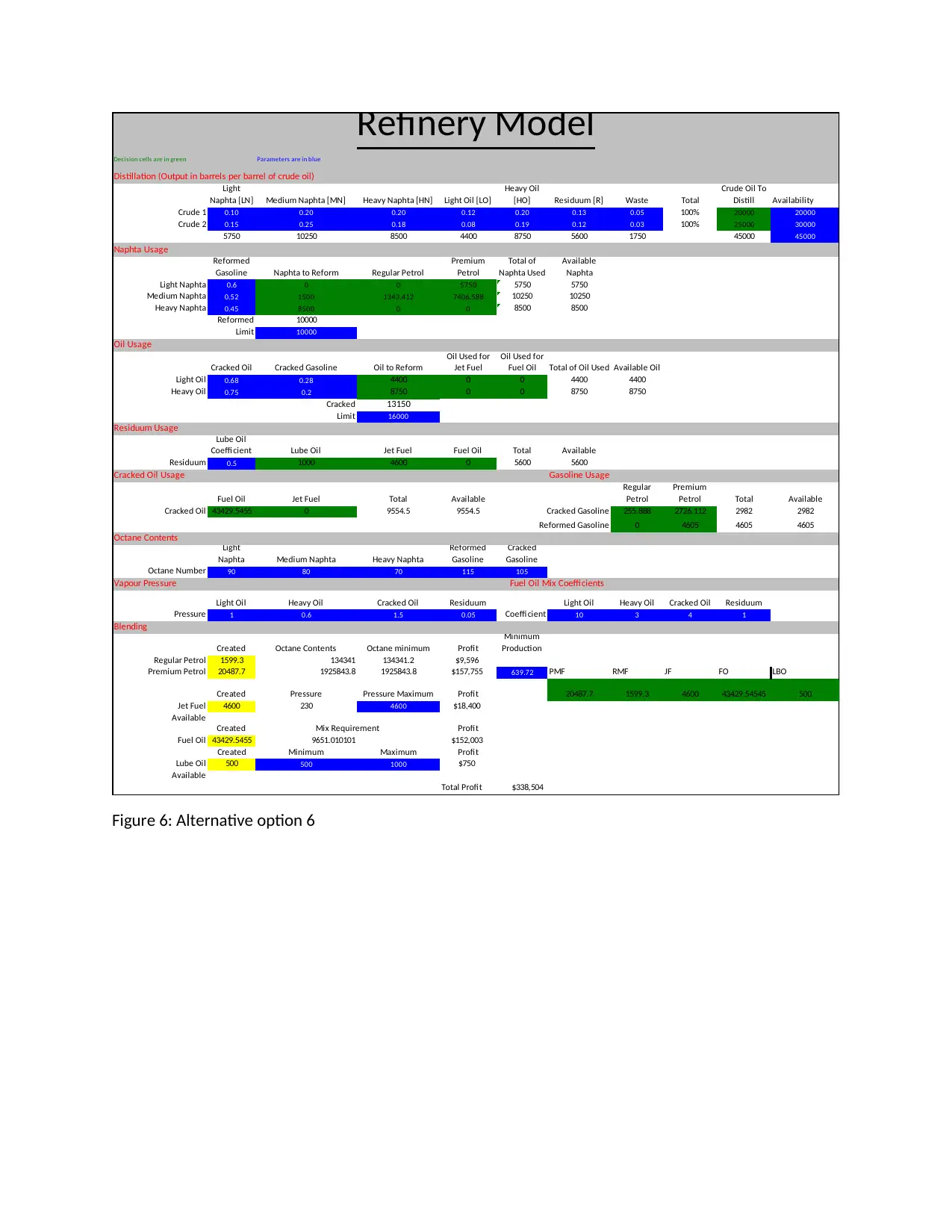
Decision cells are in green Parameters are in blue
Distillation (Output in barrels per barrel of crude oil)
Light
Naphta [LN] Medium Naphta [MN] Heavy Naphta [HN] Light Oil [LO]
Heavy Oil
[HO] Residuum [R] Waste Total
Crude Oil To
Distill Availability
Crude 1 0.10 0.20 0.20 0.12 0.20 0.13 0.05 100% 20000 20000
Crude 2 0.15 0.25 0.18 0.08 0.19 0.12 0.03 100% 25000 30000
5750 10250 8500 4400 8750 5600 1750 45000 45000
Naphta Usage
Reformed
Gasoline Naphta to Reform Regular Petrol
Premium
Petrol
Total of
Naphta Used
Available
Naphta
Light Naphta 0.6 0 0 5750 5750 5750
Medium Naphta 0.52 1500 1343.412 7406.588 10250 10250
Heavy Naphta 0.45 8500 0 0 8500 8500
Reformed 10000
Limit 10000
Oil Usage
Cracked Oil Cracked Gasoline Oil to Reform
Oil Used for
Jet Fuel
Oil Used for
Fuel Oil Total of Oil Used Available Oil
Light Oil 0.68 0.28 4400 0 0 4400 4400
Heavy Oil 0.75 0.2 8750 0 0 8750 8750
Cracked 13150
Limit 16000
Residuum Usage
Lube Oil
Coeffi cient Lube Oil Jet Fuel Fuel Oil Total Available
Residuum 0.5 1000 4600 0 5600 5600
Cracked Oil Usage Gasoline Usage
Fuel Oil Jet Fuel Total Available
Regular
Petrol
Premium
Petrol Total Available
Cracked Oil 43429.5455 0 9554.5 9554.5 Cracked Gasoline 255.888 2726.112 2982 2982
Reformed Gasoline 0 4605 4605 4605
Octane Contents
Light
Naphta Medium Naphta Heavy Naphta
Reformed
Gasoline
Cracked
Gasoline
Octane Number 90 80 70 115 105
Vapour Pressure Fuel Oil Mix Coefficients
Light Oil Heavy Oil Cracked Oil Residuum Light Oil Heavy Oil Cracked Oil Residuum
Pressure 1 0.6 1.5 0.05 Coeffi cient 10 3 4 1
Blending
Created Octane Contents Octane minimum Profit
Minimum
Production
Regular Petrol 1599.3 134341 134341.2 $9,596
Premium Petrol 20487.7 1925843.8 1925843.8 $157,755 639.72 PMF RMF JF FO LBO
Created Pressure Pressure Maximum Profit 20487.7 1599.3 4600 43429.54545 500
Jet Fuel 4600 230 4600 $18,400
Available
Created Mix Requirement Profit
Fuel Oil 43429.5455 9651.010101 $152,003
Created Minimum Maximum Profit
Lube Oil 500 500 1000 $750
Available
Total Profit $338,504
Refinery Model
Figure 6: Alternative option 6
Distillation (Output in barrels per barrel of crude oil)
Light
Naphta [LN] Medium Naphta [MN] Heavy Naphta [HN] Light Oil [LO]
Heavy Oil
[HO] Residuum [R] Waste Total
Crude Oil To
Distill Availability
Crude 1 0.10 0.20 0.20 0.12 0.20 0.13 0.05 100% 20000 20000
Crude 2 0.15 0.25 0.18 0.08 0.19 0.12 0.03 100% 25000 30000
5750 10250 8500 4400 8750 5600 1750 45000 45000
Naphta Usage
Reformed
Gasoline Naphta to Reform Regular Petrol
Premium
Petrol
Total of
Naphta Used
Available
Naphta
Light Naphta 0.6 0 0 5750 5750 5750
Medium Naphta 0.52 1500 1343.412 7406.588 10250 10250
Heavy Naphta 0.45 8500 0 0 8500 8500
Reformed 10000
Limit 10000
Oil Usage
Cracked Oil Cracked Gasoline Oil to Reform
Oil Used for
Jet Fuel
Oil Used for
Fuel Oil Total of Oil Used Available Oil
Light Oil 0.68 0.28 4400 0 0 4400 4400
Heavy Oil 0.75 0.2 8750 0 0 8750 8750
Cracked 13150
Limit 16000
Residuum Usage
Lube Oil
Coeffi cient Lube Oil Jet Fuel Fuel Oil Total Available
Residuum 0.5 1000 4600 0 5600 5600
Cracked Oil Usage Gasoline Usage
Fuel Oil Jet Fuel Total Available
Regular
Petrol
Premium
Petrol Total Available
Cracked Oil 43429.5455 0 9554.5 9554.5 Cracked Gasoline 255.888 2726.112 2982 2982
Reformed Gasoline 0 4605 4605 4605
Octane Contents
Light
Naphta Medium Naphta Heavy Naphta
Reformed
Gasoline
Cracked
Gasoline
Octane Number 90 80 70 115 105
Vapour Pressure Fuel Oil Mix Coefficients
Light Oil Heavy Oil Cracked Oil Residuum Light Oil Heavy Oil Cracked Oil Residuum
Pressure 1 0.6 1.5 0.05 Coeffi cient 10 3 4 1
Blending
Created Octane Contents Octane minimum Profit
Minimum
Production
Regular Petrol 1599.3 134341 134341.2 $9,596
Premium Petrol 20487.7 1925843.8 1925843.8 $157,755 639.72 PMF RMF JF FO LBO
Created Pressure Pressure Maximum Profit 20487.7 1599.3 4600 43429.54545 500
Jet Fuel 4600 230 4600 $18,400
Available
Created Mix Requirement Profit
Fuel Oil 43429.5455 9651.010101 $152,003
Created Minimum Maximum Profit
Lube Oil 500 500 1000 $750
Available
Total Profit $338,504
Refinery Model
Figure 6: Alternative option 6
1 out of 13
Your All-in-One AI-Powered Toolkit for Academic Success.
+13062052269
info@desklib.com
Available 24*7 on WhatsApp / Email
![[object Object]](/_next/static/media/star-bottom.7253800d.svg)
Unlock your academic potential
© 2024 | Zucol Services PVT LTD | All rights reserved.

